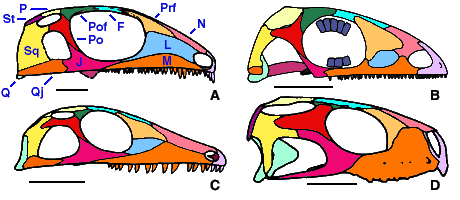A list of autapomorphies of Diapsida and Sauria appears on the Diapsida branch page, but no list of autapomorphies of the other clades was provided (for clades that are more inclusive than Sauria but less inclusive than Diapsida). Autapomorphies of these clades are given below.
Neodiapsida (all diapsids more closely related to saurians than to araeoscelidians) and Eosuchia (the last common ancestor of Coelurosauravus, Apsisaurus, younginiformes, lepidosaurs, and archosaurs and all its descendants) currently have approximately the same taxonomic content. The only neodiapsid that may not be an eosuchian is the poorly known genus Heleosuchus. Therefore, Neodiapsida and Eosuchia share the same list of autapomorphies:
- Quadrate laterally exposed (Fig. 1C, D). The quadrate (the bone with which the lower jaw articulates in most vertebrates) of araeoscelidians (Fig. 1A), "Protorothyridids", and captorhinids is covered by the squamosal laterally.
- Caniniform teeth absent (Fig. 1B, C). Caniniform teeth (anterior maxillary teeth that are much larger than other teeth) are present in captorhinids, "Protorothyridids", and araeoscelidians (Fig. 1A).
- Femoral condyles not projecting markedly beyond shaft. The femoral condyles (the structures that support the articular surfaces for the tibia and fibula) of captorhinids, "Protorothyridids", and araeoscelidians form bulbous extensions on the distal end of the shaft.
- Femoral ventral ridge system reduced. The femur of captorhinids, "Protorothyridids", and araeoscelidians has a prominent adductor crest ventrally (various muscles, including the caudofemoralis, insert on this crest).
- Proximal carpals and tarsals small. The proximal carpals and tarsals (wrist and ankle bones) of captorhinids, "Protorothyridids", and araeoscelidians are large.


Figure 1. Diapsid skulls in lateral view. A, Petrolacosaurus, a Pennsylvanian araeoscelidian; B, Claudiosaurus, an Upper Permian neodiapsid; C, Youngina, an Upper Permian younginiform; D, Clevosaurus, a Late Triassic sphenodontid (a saurian). Redrawn from A, Reisz, 1981; B and C, Carroll, 1981; D, Fraser, 1988. Scale bar equals 1 cm. Copyright © 2000 Michel Laurin.
Apsisaurus, Claudiosaurus, younginiforms, and saurians share the following synapomorphies:
- Trunk neural spines at least as high as long. The neural spines of "Protorothyridids", some araeoscelidians, and Coelurosauravus are low.
- Olecranon process absent. An olecranon process (a structure on which the triceps is inserted) is present on the ulna of "Protorothyridids", araeoscelidians, and Coelurosauravus.
Claudiosaurus, younginiforms, and saurians share the following synapomorphies:
- Clavicles narrow medially. The clavicle (a dermal bone of the shoulder girdle) of Captorhinids, "Protorothyridids", araeoscelidians, and Apsisaurus is broad medially.
- Interclavicle with slender lateral processes. The interclavicle (another dermal bone of the shoulder girdle) of araeoscelidians and Apsisaurus has a large, rhomboidal head.
- Intertrochanteric fossa reduced. The proximal head of the femur of araeoscelidians and Apsisaurus is deeply excavated ventrally by the intertrochanteric fossa.
Younginiforms, ichthyosaurs and saurians share the following synapomorphies:
- A single coracoid. The evolution of this character is poorly documented because the endochondral shoulder girdle elements are often coossified in the adults, but captorhinids (Holmes, 1977), "Protorothyridids" (Carroll and Baird, 1972), and araeoscelidians (Reisz, 1981) have two coracoid ossifications (anterior and posterior).
- Loss of the tabular. This bone is present at the back of the skull of "Protorothyridids", araeoscelidians, and it may have been present in Claudiosaurus.
Ichthyosaurs and saurians share the following synapomorphies (Motani et al., 1998):
- External nares close to the midline. In other diapsids, the external naris is located farther laterally and the snout is broader.
- The occipital flange of the squamosal is little exposed on the occiput.
- Postparietal absent.
- Sphenethmoid absent.
- Presacral intercentra absent.
- Entepicondylar foramen absent. This foramen pierces the dorsal surface of the posterior part of the distal head of the humerus in most other diapsids.
- Radius as long as ulna. In most other diapsids, the radius is shorter than the ulna.
- Perforating foramen of manus lost.
- Fifth distal tarsal absent.
Position of problematic taxa
Galesphyrus (Carroll, 1976a), Heleosaurus (Carroll, 1976b), and Heleosuchus (Carroll, 1987) are problematic because they are incompletely known. These taxa were placed on the most basal position on the tree that was consistent with the derived characters that could be identified.
Galesphyrus
Galesphyrus possesses the following derived characters:Neodiapsid characters:
- Quadrate condyles not projecting markedly beyond shaft.
- Proximal carpal and tarsals small.
Synapomorphies shared with Apsisaurus, Claudiosaurus, younginiforms, and saurians:
- Olecranon process absent.
Synapomorphies of Apsisaurus, Claudiosaurus, younginiforms, and saurians:
- High neural spines.
Saurian synapomorphies:
- Small lateral manual centrale.
- Fifth distal tarsal absent.
- Fifth metatarsal hooked.
Very little evidence supports the placement of Galesphyrus in the diapsid phylogeny, but this taxon appears to be closely related to Apsisaurus, Claudiosaurus, younginiforms, and saurians. It may be more closely related to saurians than suggested in the main tree (in the Tree of Life page), but more data is required to test this hypothesis.
Heleosaurus
Heleosaurus possesses the following derived characters:Neodiapsid characters:
- Quadrate laterally exposed.
- Femoral condyles not projecting markedly beyond shaft.
- Femoral ventral ridge system reduced.
Characters shared with Apsisaurus, younginiforms, and saurians:
- Trunk neural spines at least as high as long.
Characters shared with Claudiosaurus, younginiforms, and saurians:
- Intertrochanteric fossa reduced.
The presence of the other characters in Heleosaurus cannot be assessed, but the available evidence suggests that it is more closely related to Claudiosaurus, younginiforms, and saurians than to Apsisaurus.
Heleosuchus
Heleosuchus retains an olecranon process, a structure lost in all other early neodiapsids except for Coelurosauravus. However, the status of the other characters cannot be unambiguously determined. The shape of the ectopterygoid described by Carroll (1987) suggests that a suborbital fenestra was present, and this would confirm the diapsid status of Heleosuchus. The position of this taxon will have to be reassessed when better material is discovered.





 Go to quick links
Go to quick search
Go to navigation for this section of the ToL site
Go to detailed links for the ToL site
Go to quick links
Go to quick search
Go to navigation for this section of the ToL site
Go to detailed links for the ToL site